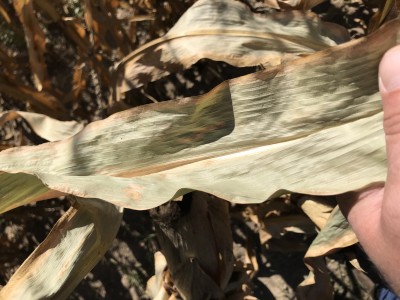Local Frost Advisories - What it Could Mean for Corn Producers in Southwest New
Joshua Putman, Field Crops and Forage Specialist
Southwest New York Dairy, Livestock and Field Crops Program

Frost can mean yield loss for crop producers, although the severity of damage varies based on crop maturity, topographical features and local climate conditions. A corn-killing freeze occurs when temperatures fall to 32 F for several hours or 28 F for a few minutes.
Damage occurs from freezing temperatures because living plant tissues contain water. As ice crystals form, they expand and puncture cell walls. As the temperatures rise during the morning, the ice crystals melt back to a liquid. The punctured cells lose water and nutrients and die. Frost damaged plant tissue often has a water-soaked appearance. This appearance later turns into brown, dead plant tissue. Damage will start to show up 1 to 2 days after a frost has occurred.
Late-season frost damage can affect grain quality and yield and is directly proportional to the stage of maturity and leaf tissue killed. Severe impacts on grain quality can occur at mid-dough, while moderate impacts are seen at the dent stage. By the time the kernel has reached half milk line, only minor impacts will occur to grain quality. Yield losses are negligible if frost occurs when grain moisture is below 35 percent. Differences among hybrids, overall plant vigor at the time of frost, and subsequent temperatures will all affect final grain quality and yield.
Severe plant tissue damage can lead to defoliation. If you suspect your corn has been damaged by frost, you should consider consulting the National Corn Handbook NCH-1 "Assessing Hail Damage to Corn" (Vorst, 1990). This publication has charts used by the National Crop Insurance Association for assessing yield loss due to defoliation. Knowing how to recognize frost damage and assess probable loss is important for decision making. An abbreviated version of the loss chart is shown in Table 7 below. For example, corn that was defoliated 20% at the milk stage would have 3% yield loss.
Frost damage can be difficult to identify late in the season as it is easily confused with common fungal leaf diseases such as northern corn leaf blight. If you have questions regarding the condition of your corn crop or if you don't have access to an electronic version of the "Assessing Hail Damage to Corn" guide, contact Josh Putman. For more information on corn maturity and frost, visit https://www.agry.purdue.edu/ex...
Upcoming Events
Crops, Cows & Critters - Southwest New York Dairy, Livestock & Field Crops Newsletter Sponsorship
December 19, 2025
Our two forms of publications feature research-based and timely information from our four specialists, listed to the right, along with local event notifications and Cornell University outreach. This information is provided to participants who range from dairy, livestock, and field crops producers to agricultural suppliers and consultants.
Weekly Email Update: Shared with 625+ households who have signed up with our program.
Monthly Paper Mailer: To reach our stakeholders and farmers who lack internet access, we send out a monthly mailer where your company's logo and contact information would be featured with a mailing list of 330+ households.
If you sponsor our weekly and monthly publications you reach approximately 955 households.
Visit our website to view our newsletters!
2025 Cornell Food Beverage & Animal Feed Manufacturer Survey
December 19, 2025
Industry and Educational Advocates for New York State's Food, Beverage, and Animal Feed Manufacturing industries:
As you know, NYS has a diverse food and beverage manufacturing industry, in both the types of industries that exist and the wide distribution of firms by scale. Many manufacturing firms have strong backward linkages to agricultural production sectors in the state that support both farm-level and downstream food industry firms and consumers. In collaboration with the New York State Department of Agriculture and Markets, a team from Cornell University's Charles H. Dyson School of Applied Economics and Management has recently rolled out the 2025 New York State Food, Beverage, and Animal Feed Manufacturer Survey. The industry will benefit from an updated assessment of the industry that informs private and public investments and opportunities to support firm growth and improved profitability.
Boots in the Barn: Cornell Dairy Research Updates
January 13, 2026
January 20, 2026
January 27, 2026
February 3, 2026
February 10, 2026
February 17, 2026
February 24, 2026
Join us for some or all!
Announcements
No announcements at this time.





